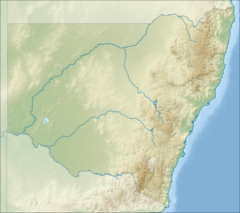Sugarloaf Point Light

Sugarloaf Point Lighthouse
|
|
|
New South Wales
|
|
| Location |
Seal Rocks New South Wales Australia |
|---|---|
| Coordinates | 32°26′27.45″S 152°32′21.25″E / 32.4409583°S 152.5392361°ECoordinates: 32°26′27.45″S 152°32′21.25″E / 32.4409583°S 152.5392361°E |
| Year first constructed | 1875 |
| Construction | rendered brick tower |
| Tower shape | cylindrical tower with balcony and lantern lantern, external spiral stairway |
| Markings / pattern | white tower and lantern, black balcony rail |
| Height | 49 feet (15 m) |
| Focal height | W. 258 feet (79 m) R. 240 feet (73 m) |
| Original lens | 1st order Chance Brothers Fresnel lens |
| Light source | mains power |
| Intensity | 780,000 cd |
| Range | white: 25 nautical miles (46 km; 29 mi) red: 14 nautical miles (26 km; 16 mi) |
| Characteristic | Fl W 7.5s. F R (toward south) |
| Admiralty number | K2776 |
| NGA number | 111-6048 |
| ARLHS number | AUS-155 |
| Managing agent | Australian Maritime Safety Authority |
|
[]
|
|
Sugarloaf Point Light, also known as Seal Rocks Lighthouse, is an active lighthouse located on Sugarloaf Point, a point about 3 kilometres (1.9 mi) southeast of Seal Rocks, New South Wales, Australia. It guards Seal Rocks, a treacherous rock formation to the south. It is the first lighthouse designed by James Barnet. It is also one of only two towers in Australia with an external stairway.
The first recorded recommendation for building a lighthouse to guard Seal Rocks was made by a committee of the New South Wales Legislative Assembly in 1863. Original intentions were to place the lighthouse on the Rocks, but because of access difficulties the location finally chosen in 1873 was Sugarloaf Point. The lighthouse was designed by James Barnet, the New South Wales Colonial Architect of the time. Tenders were called in 1874. Construction required building a 1,500 feet (460 m) long jetty, which was used to land the 1,800 tonnes (1,800 long tons; 2,000 short tons) of supplies and materials required for the construction. Construction was completed in 1875 and the light was first lit on 1 December 1875.
The original lens, still present, is a first order Chance Bros. sixteen-panel Fresnel lens dioptric. The original light source was a kerosene lamp with a light intensity of 122,000 cd. This was upgraded in April 1923 to a carbide lamp with an intensity of 174,000 cd.
In June 1966 the light was converted to electricity and the intensity raised to 1,000,000 cd. and automated in 1987, though a caretaker remained on the site until 2006-2007, when the residence was renovated to be used for tourist accommodations. The last caretaker was Mark Sheriff, who was previously stationed in Green Cape Lighthouse.
The current light is a 120 V 1,000 W quartz halogen lamp, powered by mains electricity with a backup diesel generator. The light intensity is 780,000 cd, and the light characteristic shown is flashing white with a cycle of 7.5 seconds. Also showing is an additional fixed red light, with a similar 120 V 1,000 W quartz halogen lamp, visible to the south, over Seal Rocks and other dangers. This secondary light is positioned at a lower height, and was originally green, changed to red in the 1980s.
...
Wikipedia

